6 tactics to rank better in Google Discover
While you can’t target users or interests, you can increase your chances of ranking better in Google Discover. At SMX Next, John Shehata shared the tactics he uses to up the odds and analyze what works.
Google’s Discover feed presents mobile users with a stream of content based on the user’s interests. For publications that have managed to get their content featured in it, the Discover feed can drive substantial traffic — but, unfortunately, “there’s no way to create content that explicitly targets Discover’s interest matching,” John Shehata, VP, global audience development strategy & CRM at Condé Nast, said, quoting Google during his session at SMX Next.
“That’s absolutely true, but there are certain things [that you can do to] increase your chances of ranking well in Google Discover,” he added. Using data obtained from one million pages (equating to 27 billion impressions) over the prior 90 days, in tandem with his own experience, Shehata provided the following tactics publishers can use to strengthen their ability to rank in Google Discover.
Use emotional titles, not clickbait
“When we analyzed the titles that perform very well in Google Discover [the top titles above 25% CTR and have at least 10,000 impressions] . . . You will see a lot of them are in that area of ‘clickbaity,’ so is there bait and switch?” Shehata said.
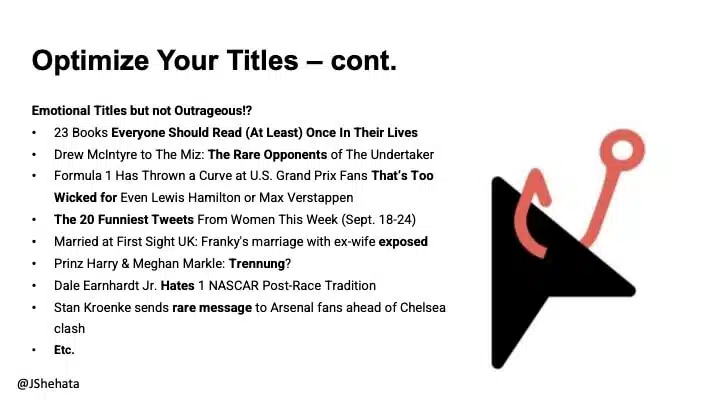
“No, that will not work, if you promise one thing and you go to the site and it’s completely something else, Google can recognize this very well, but emotional titles still work very well,” he said, pointing out that there is a fine line between clickbaity, outrageous titles and titles with an effective emotional element.
Additionally, data from GD Dash, which Shehata used throughout his presentation, revealed that 13% of the top 100 articles in Discover (with a 25%+ CTR and >10,000 impressions) were listicles. For brands looking to attract Discover traffic, Shehata cautions them against using 10-item listicles: “It gets the lowest CTR. People think it’s generic and it’s a made-up list, so try to avoid ‘10,’” he said.
Include high-quality visuals
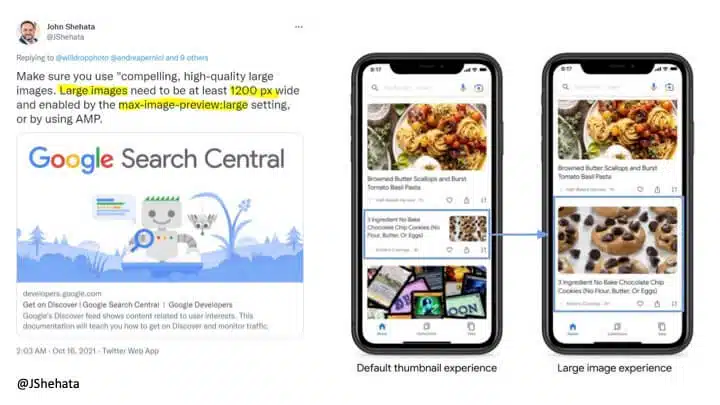
“I cannot stress enough how important this is,” Shehata emphasized, providing the following guidance:
- Your larger images should be at least 1200 pixels wide and enabled by the max-image-preview:large setting or by using AMP. “That will transfer your small images, like this on the left [in the screenshot above] to the right size, which is the full-width image,” he said, adding, “I have seen this increase CTR by two or three times.”
- Use 16:9 aspect ratio for hero images.
- Avoid using a site logo as your image.
- Avoid manipulated media.
- Use a descriptive file name for the image.
- Add appropriate alt text.
- Use a descriptive caption.
Understand and enhance E-A-T signals
While Search and Discover are different products, the overall principles of E-A-T as they apply to content are similar. In 2020, Google added the term E-A-T (expertise, authoritativeness and trustworthiness) to its Discover guidelines. “This phrase has not been there before,” Shehata said, “They’re going to be looking at E-A-T when they are evaluating Google Discover content.”
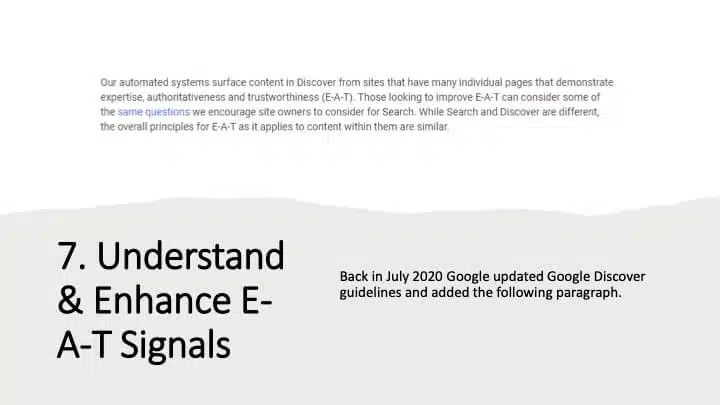
Demonstrating E-A-T within your content can help you convince Google that it is reliable, free of misinformation, serves users and is thus worth recommending to them. One way to increase your E-A-T is through optimizing your author pages.
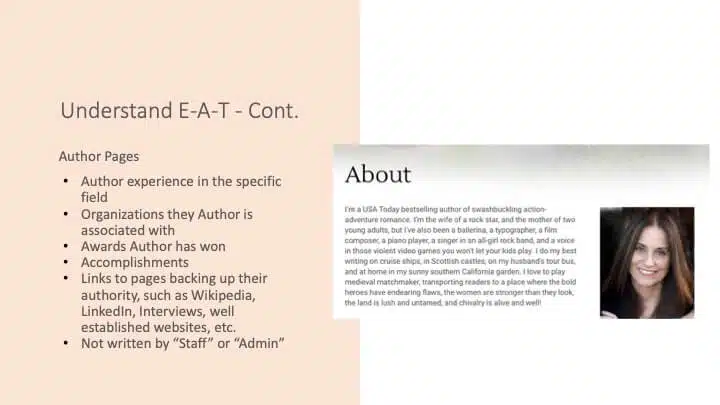
“Make sure to avoid as much as you can — because there are certain exceptions — ‘Written by staff’ or ‘Written by admin,’” Shehata said about article authorship, “This doesn’t transfer any good E-A-T or trust signals.”
He also provided the following ways to bolster your E-A-T for Google and for your readers:
- Secure your site by using HTTPS.
- Include dates, bylines and information about authors in your articles.
- Provide information about the publication, the publisher and/or the company behind it.
- Include contact information for greater trust and transparency.
- Link to the author’s social media profiles.
Use the API to identify topics and entities that work for your brand
Now that Discover data is available in the Google Search Console Search Analytics API, publishers can utilize Google’s natural language processing to identify which entities interest their audiences and work for their publications.

“Once you utilize the Google Discover API and run it through Google natural language processing, you start to figure out what topics work for you,” Shehata said, adding that publishers should “double down on these topics” since Google already considers them to be an authority on those subjects.
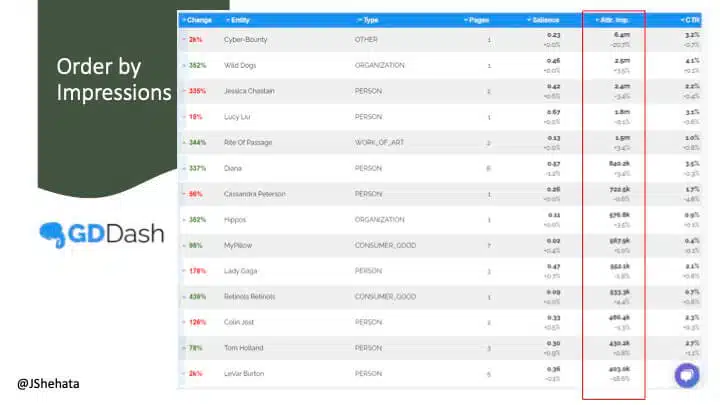
These topics can be sorted by impressions, CTR or number of pages. Sorting by impressions shows you the topics in which you have the most visibility, and by extension, authority. Ordering by CTR can tell which topics your audience is engaging with. And, sorting by the number of pages and referencing CTR, for example, may help you identify opportunities to improve your content.
Refresh your evergreen content
Updating your evergreen content can help drive additional Discover traffic. In the image below, clicks spiked each time the article was refreshed.
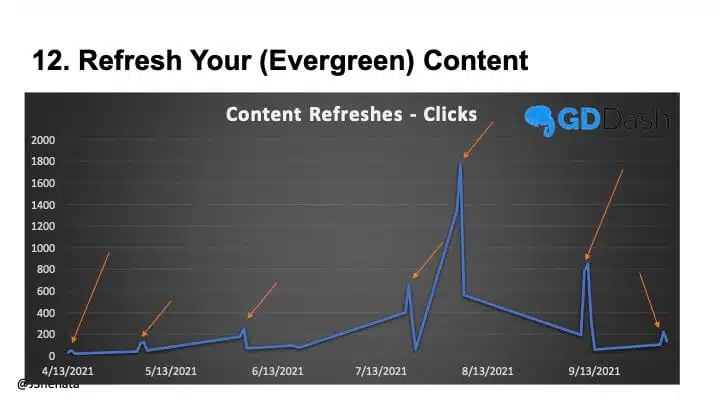
RELATED: How to breathe fresh life into evergreen content (and get fresh traffic, too)
Publishers should make sure to use the same URL and tweak the headline every once in a while, Shehata recommended.
Understand your Google Discover data
Establishing a baseline contextualizes your data and lets you know which stories performed above or below average. To that end, it’s important to understand:
- Your average CTR per category;
- Your average impressions per story; and
- Your average daily life span per story.
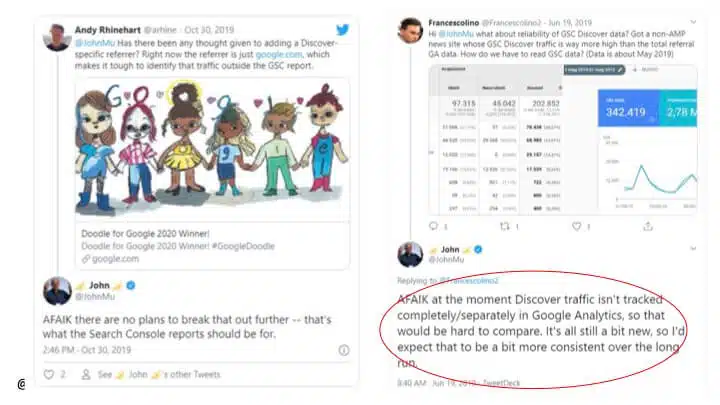
It’s also important to understand that traffic from Discover is categorized as “direct” in Google Analytics (see the screenshots above). “I would assume about maybe 25% to 30% of direct traffic in Google Analytics is Discover traffic, so pay attention to this,” Shehata said.
Remember, Google Discover is a supplemental channel
“A word of caution . . . I want to make sure that you know that you should not be addicted to Google Discovery traffic — it’s not predictable and it shouldn’t be considered a core strategy of your SEO,” Shehata said. While the additional traffic may help you reach business goals, you cannot rely on Discover to deliver a consistent stream of traffic since there’s no way to target users or interests.
That having been said, most of the topics Shehata covered also lend themselves to your regular search strategy, so there’s little additional work to put in to specifically optimize for Discover, but a lot of traffic that may potentially be gained.
Watch the full SMX Next presentation here (registration required).
Contributing authors are invited to create content for Search Engine Land and are chosen for their expertise and contribution to the search community. Our contributors work under the oversight of the editorial staff and contributions are checked for quality and relevance to our readers. The opinions they express are their own.
Related stories
New on Search Engine Land